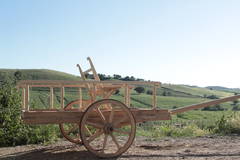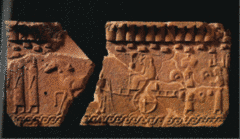14 June 2013
Reconstruction of an Etruscan cart

Etruscan cart reconstruction, incomplete

The nuptial procession, Poggio Civitate, Murlo (Siena), VI century b.C.

Talamone Pediment, second half of the II century b.C.
The Tuscan showcase in Maremma revolves around a traveling exhibit, used to retrace one of the main commercial routes of ancient times: the Via dell'Ombrone, winding its way inland from the shores of the Tyrrhenian Sea. In the course of the Notti dell'Archeologia, a series of events held in Tuscany in July, an ancient Etruscan cart reconstructed specifically for the event, will slowly make its way from Castiglione della Pescaia towards Rusellae.
The team responsible for the cart is the Associazione Culturale Archeoworld, lead by Dr. Riccardo Chessa. They approached the task through experimental or reconstruction archaeology, which is not yet a widespread discipline in Italy.
Artisans with experience in building carts and cartwheels, and botanists were consulted when deciding which construction materials to use. Indigenous plants found in Mediterranean Scrub were chosen according to the different function of the elements of the cart. Three different types of wood were used on the wheels alone: elm (ulmus minor), oak (quercus pubescens) and ash (fraxinus excelsior).
A decorative frieze showing a nuptial procession suggested the dimensions of the cart, which are based on the comparison between the size of the wheels and the height of the human figures represented. Based on this analysis, the wheels have a diameter of 90 cm, and were the most difficult part to reconstruct. The model chosen as a reference example was found on the Talamone pediment, which shows each minute – almost photographic – detail.
Although there are abundant depictions of ancient Italian carts and chariots, there weren’t many examples to employ as a model for the reconstruction, as some were just fragments, others carts had different purposes. The available imagery covers a very long period, going from the Archaic-Orientalizing Age to the Hellenistic Age (VII-II century b.C.), therefore the reconstruction is the product of a careful study of all the available artefacts.
back
Latest Showcases News
15 September 2014
Salzburg's Showcase wrap up. An interview with Julia Eder
11 September 2014
CATALONIA'S SHOWCASE WRAP UP. LESSONS LEARNED AND OBJECTIVES ACHIEVED
21 August 2014
Salt route on the showcase portal
23 July 2014
Georg Trakl - places and poems
11 July 2014
mNACTEC launches the book "Recovered spaces, new uses of industrial heritage in Catalonia"
08 July 2014
Field workshop summary: Terrassa Augmentada


